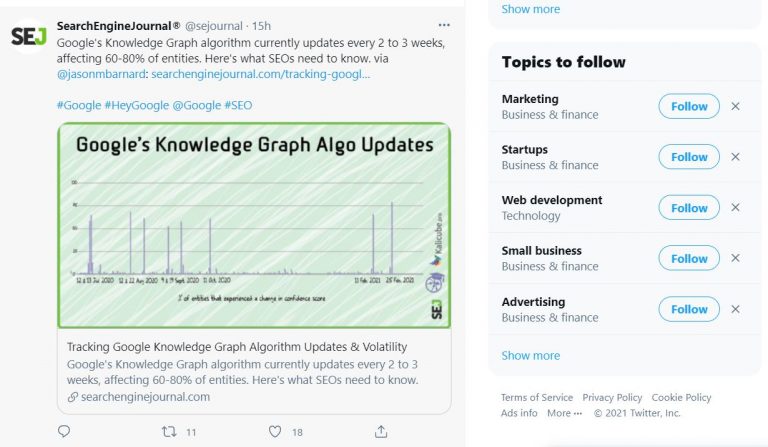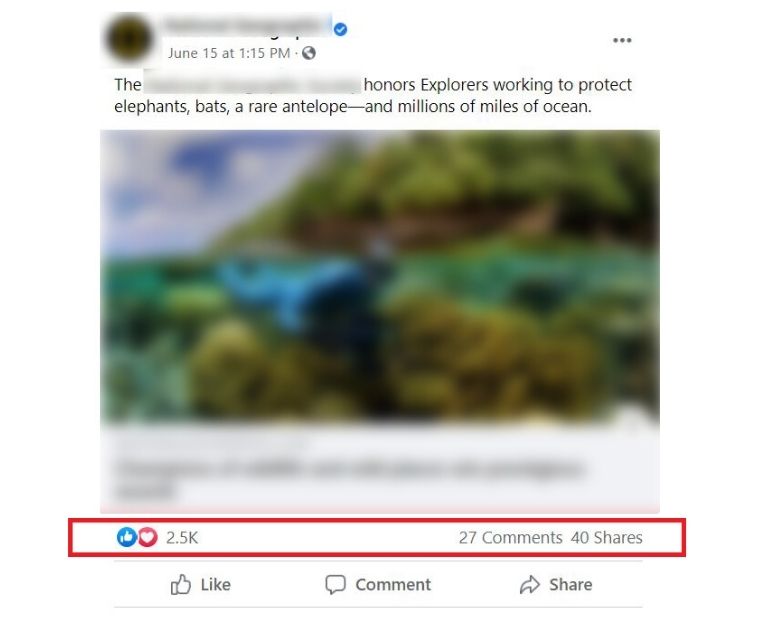Social media can positively impact your website’s SEO performance and boost your Google search rank.
Yet too many marketers still silo SEO and social media marketing versus seeing them together as one holistic ecosystem.
Social media marketing can and should be a valuable ally to SEO.
Let’s take a look at five ways social media can benefit SEO and why the two should be working together. You’ll learn social media strategies to maximize the impact it has on your organic search efforts.
How Does Social Media Impact Website SEO?
First, it’s important to recognize that social media does not directly boost search rankings.
There’s a lot of mixed messaging out there on this topic, despite numerous studies and claims.
Google itself has sent out conflicting signals – Matt Cutts, who was the head of Google’s webspam team at the time, released a video in 2010 claiming, “Yes, I can confirm it. We do use Twitter and Facebook links in ranking, as we always have in our web search rankings…”
But four years later, Cutts released another video saying that social signals including Twitter Follows and Facebook Likes do not affect search rankings.
Google, he explained, crawls the web for information, effectively taking a snapshot of that moment in time. But social media is updating constantly and sending incomplete signals, so it’s not providing a comprehensive picture.
Since then, multiple studies have been published, including this one mid-2020 from Semrush, which cites a CognitiveSEO study of 23M+ social shares. The discovery was that shares on social media sites have no real impact in SEO rankings.
Still, the study found that when more people share content on social media, it actually does generate social signals that indicate your posts are useful to your target market.
You might be thinking, “Okay, so links to my content on social media are good for SEO, but the number of followers and likes I have don’t affect my ranking. Right?”
Well… it’s hard to say for sure. Google hasn’t said much on the subject in recent years.
Some studies have cited a correlation between high shares and high rankings on certain social media platforms, but the problem is, correlation is not the same as causation.
Any correlations are more likely an indicator that a website is doing a good job of producing high-quality content that is engaging audiences on both social media and organic search traffic channels.
Search engines are also limited by the challenge of assessing the true identity and authority of social profiles, which makes it difficult for them to know how much value to give a link.
We know that Google doesn’t consider a share on Facebook to be equivalent to a backlink from an authority site. But social media does influence SEO in other, less direct ways, including:
- Distributes content.
- Raises brand awareness.
- Enhances brand reputation and authority.
- Improves the lifespan of a post.
- Increases organic traffic and online visibility.
All of these benefits add up to have a notable impact on your SEO ranking.
5 Ways Social Media Supports Organic Search Marketing Campaigns
If it’s unlikely that social media directly affects your brand’s search rankings, then what’s the value of uniting your social media and SEO strategies?
Here are five ways to leverage social media for SEO benefit.
1. Create Link Opportunities
The number one opportunity on this list is also the hardest to achieve.
The difficulty lies on the recipient side rather than the actual implementation because this method is passive. It’s dependent on a third party taking action without a direct push from you.
Put simply, you are relying on social media to promote your content and make people aware that it’s out there.
It’s amazing how much fantastic content was clearly well researched and took many hours to produce, yet gets little or no promotion.
Countless times, I’ve stumbled upon a piece of content on social media that made an impression. I may save it to reference later, often in the form of a citation or quote linked in one of my posts.
I mentioned before that a link on Facebook isn’t equivalent to a backlink on another site. But the Facebook link did make me aware of the content’s existence so I could reference it on my website.
This is what I mean when I say it’s a passive way of creating link opportunities by promoting your content.
Takeaways
- Create a social media marketing strategy to promote your content (which might vary depending on the type of content and where you share it).
- Develop a standard operating procedure (SOP) to ensure each new piece of content goes through the sharing strategy.
- Keep an updated list of evergreen content that should be reshared regularly. Remember: Social media shows your content to only a small portion of your potential audience, so a single share isn’t reaching everyone who follows you.
2. Increase Brand Awareness and Positive Mentions
Google’s Search Quality Raters Guideline document shows human raters do factor brand mentions into the equation when considering a website’s reliability. That doesn’t mean the algorithm does, as well — but we know these guidelines are representative of what matters to Google.
This is where social media can play a major role in the overall perception of your brand. Companies with a strong social media presence and respond directly to their customers there see a noticeable increase in overall satisfaction.
Companies on Twitter, for example, reported a 19% boost in overall customer satisfaction.
This affects the sentimentality of brand mentions as a whole, including in customer reviews and public forums. You want people to be talking about good experiences with your brand, not bad ones.
Google pays attention to the context of your online engagement and how people talk about you, which impacts what you rank for.
Notice that I said what you rank for, not how high you rank.
Google uses online mentions to categorize you as relevant (or irrelevant) for search queries, depending on a variety of factors. You want to keep your brand mentions positive, and social media is a solid tool to help you do that.
Takeaways
- Find ways to encourage positive mentions of your brand on social media and other places.
- Use social media to grow an audience of true brand advocates.
- Tailor your messaging on different social platforms for maximum success based on your audience.
3. Build Partnerships
Although I still systematically share content on social media in a tried-and-true fashion, I’ve been shifting more of my time toward building relationships on social that are likely to lead to potential partnerships.
The unfortunate truth is that it’s becoming more and more difficult to reach your audience organically on social media.
But these platforms were originally designed to connect people and foster relationships, and they still excel at that function.
There are three relationship-building levels you should be focusing on:
- Brand advocates: Active social media fans who are loyal to your brand and promote you for free, multiplying your effectiveness without costing an extra penny.
- Organic influencers: Unlike paid influencers, these are social media accounts that have genuine expertise, authority, and trustworthiness (the E-A-T formula) within your industry. Any positive endorsements of your brand, products, or services carry a lot of weight with their engaged audiences.
- Strategic partners: Non-competitive businesses or influencers within your niche who are willing to partner up and co-create valuable content that taps into both of your audiences for crossover marketing opportunities.
Let me give you an example of how partnerships can grow and be beneficial.
Over the course of several years, I cultivated a relationship with Steve Rayson, the co-founder of BuzzSumo. I interacted with his posts and shared his content on a regular basis, and I even offered helpful insights on several occasions.
In early 2018, he sent me an advance copy of a BuzzSumo blockbuster report he’d authored about massive social engagement shifts and trends.
Because we already had an established relationship (I wasn’t a stranger reaching out via cold contact to seek a favor), I asked him if I could summarize the report for Search Engine Journal and publish it as soon as the report was released to the public. Rayson gave his blessing.
The result: My article New Content Trends Report: Social Sharing Down 50% Since 2015 was the first announcement most of the public saw, and it earned 3,900+ reads and more than 1,000 shares.
This is just one example of how forming beneficial relationships through social media can open otherwise inaccessible opportunities to expand your reach.
Takeaways
- Dedicate more of your social media efforts to developing relationships in the three levels we covered earlier.
- Create a list of accounts to target for relationship building. Keep this list up to date, and make sure you’re giving each account regular attention.
- Don’t just smash the like button over and over again. Make efforts to engage with people. Leave comments, answer questions, and offer professional feedback when appropriate.
4. Establish Authority
Social media, content marketing, and SEO go hand-in-hand.
One of the primary benefits of content marketing is that if you’re consistently publishing high-quality content, you establish yourself as an expert within your niche over time.
People come to trust the information you provide, and that trust starts to encompass your brand as a whole.
That’s good news because Google’s evaluation of your website’s authority and trustworthiness plays a huge factor in your search ranking success.
Now, add social media into the mix as a megaphone to push your authoritative content out into new channels and broaden your overall reach, brand awareness, and discoverability.
People aren’t constrained to only one digital sphere. They access a variety of different resources every day, which is why omnichannel marketing is such an effective technique to reach consumers no matter where they are.
Even if your Twitter and Facebook follower totals aren’t part of Google’s formula (and it’s hard to say one way or the other with 100% certainty whether that really is the case), you’re still reaching a wide audience and winning their trust.
This will have a positive impact in other ways – shared content, word-of-mouth marketing, customer reviews, new leads, public forums, organic site traffic, and the list goes on.
Sprout social recommends these as the best times to post on social media in 2021:
- Facebook: The best times to post are Tuesday, Wednesday, and Friday between 9 am and 1 pm. The worst day of the week to post on Facebook is Saturday.
- Instagram: The best days to post are Tuesday between 11 am and 2 pm, and Monday through Friday at 11 am. Sunday is the worst day to post on Instagram.
- Twitter: The best time to tweet is on Wednesday between 9 am and 3 pm, and Tuesday through Thursday between 9 and 11 am. The worst day of the week to post on Twitter is Saturday.
But social media should not be the primary source of the authority you’re working to build around your brand.
Having your own domain is imperative. Using social media itself, or even a free website hosted by WordPress, Wix, Joomla, etc., to build your authority puts your content outside of your control.
If those sites were to shut down, all of your content and the authority you’d developed would be history.
Your website on its own domain is your home base. Your social media channels, in addition to serving as separate brand awareness funnels, should be directing traffic back to your website.
Think of it this way: all roads that carry your content should lead back to your base where you have laid down your foundations.
Tweets, LinkedIn and Facebook posts, YouTube videos, guest blogs on other sites, podcast features, etc. are secondary content distribution channels.
These should be establishing your authority and also funneling traffic back to your primary source where people can learn more.
For example, see how Search Engine Journal shares relevant articles on Twitter while tagging the author (and Google, since it’s relevant to the post), using a few select hashtags, and redirecting users to the actual article on their website when they click on it:

This technique helps to build credibility and connections with their authors and sources. People are able to discover this article when searching these hashtags, and authors are encouraged to share the content with their own audience.
Takeaways
- If you don’t already have a domain for your website, you need to invest in one so you can build your authority on a site you own and control.
- Content marketing, SEO, and social media are all interconnected. Rather than treating each as a separate piece in your marketing strategy, look at them as a whole and plan accordingly to make everything work together. Leverage secondary channels to circulate traffic back to your primary authority site.
- Be strategic with your social media posts. Use analytics and other resources to determine the best days and times for maximum impact.
5. Boost Content Lifespan and Engagement
We touched on this topic in the first point on this list when discussing link opportunities.
You might be writing and publishing amazing content but if people aren’t finding it, you’re not getting the traffic and backlinks you should be.
Sharing your content on social media platforms can help people discover your content and brand. But just as importantly, it can give the content a longer lifecycle as it’s shared and circulated.
The first trick here is to make sure your content is engaging. If it’s not, it doesn’t matter what you do – people aren’t going to be interested.
Engaging content needs to connect with its audience and serve a purpose. Content should do at least one of the following:
- Present a solution to a problem.
- Educate someone on a topic of interest.
- Entertain a person in some way.
- Connect with someone on an emotional level.
Truly great content falls into multiple categories.
One of the easiest ways to determine whether your content is engaging with your audience is in the form of likes, comments, and shares.

Start paying attention to which forms of content are getting the most reactions. Is it sparking discussions? Are people sharing it? Tagging friends?
Or is your content sitting there to the tune of crickets?
Take note of how your audience is reacting. There are tons of social media analytical tools available, both within the platform itself as well as third-party resources to help you identify which topics and types of content are connecting.
If you’ve ticked that first checkbox and have engaging content, then your social media strategy needs to kick in to help push that content out in front of your audience. The more relevant the content, the better your chances of getting likes, comments, shares, and tags that will keep the momentum going.
Make that happen by taking proactive measures such as tagging influencers and business partners, choosing the right hashtags, hosting content and giveaways to reward people for their engagement, and other techniques.
The right content with a strong social media marketing strategy can dramatically extend the reach and lifespan of your content.
This is also the case for old content that was (and maybe still is) performing well.
Refreshing the content to keep it updated and then recirculating it back through social media channels can give it a major boost and stretch the life of your content so it continues to be a high performer.
Takeaways
- Sharing content on social media will make it discoverable and extend its lifecycle as people continue to share it over a period of time.
- Your content strategy and social media strategy, including analytics for both, need to be working together. You should be publishing engaging content that people will want to talk about and share.
- High-performing old content should be updated and recirculated to maximize its lifespan.
More Resources:
- Top 9 Benefits of Social Media for Your Business
- The Top 10 Social Media Sites & Platforms 2021
- Social Media Marketing: A Complete Strategy Guide
Image Credits
All screenshots taken by author, June 2021




